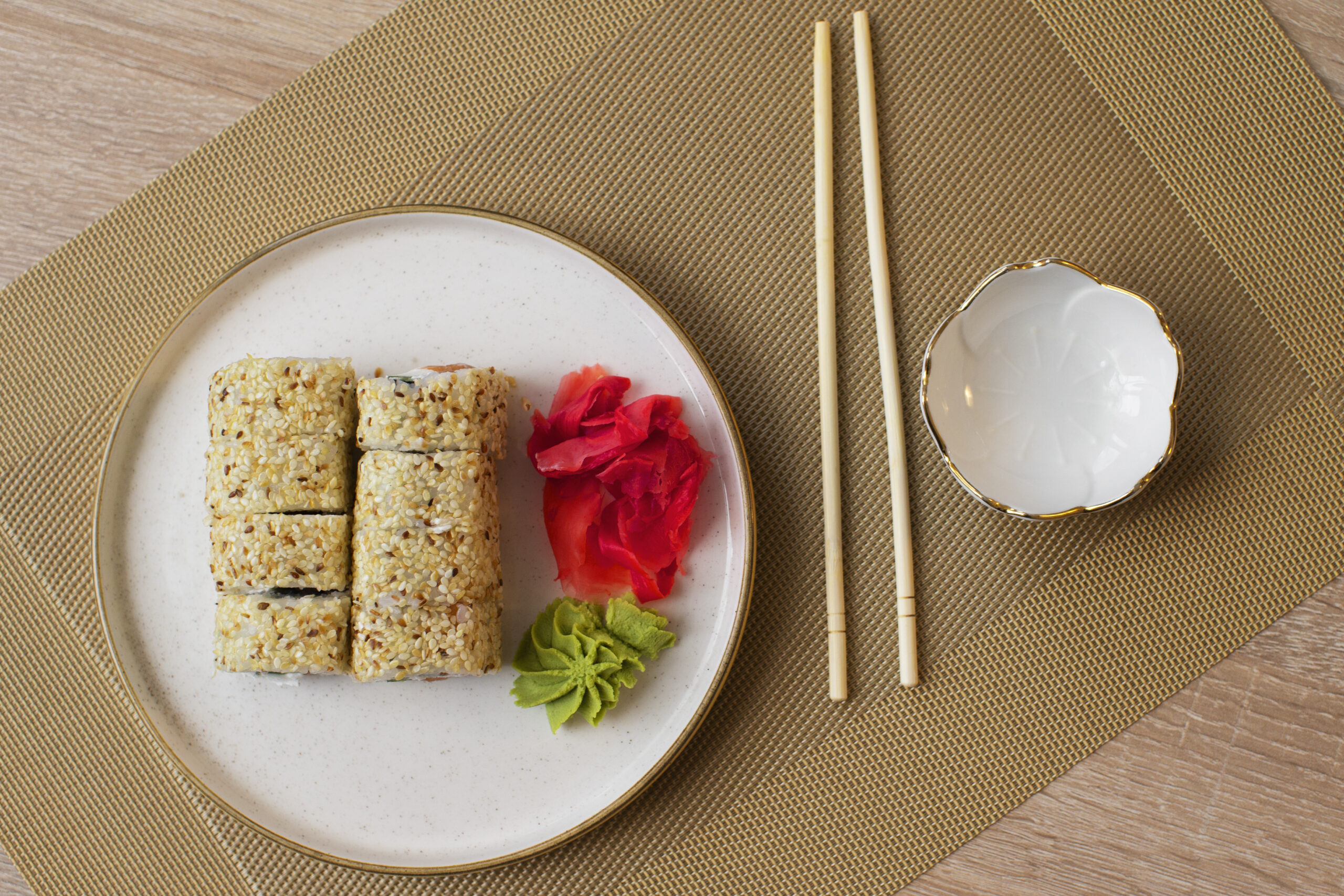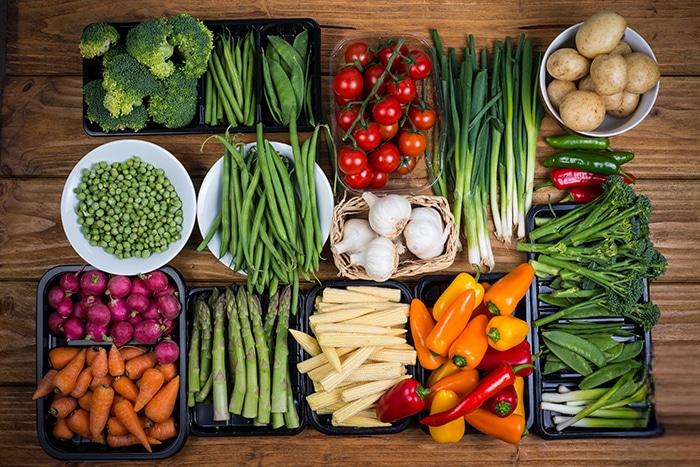Sushi, the elegant and iconic dish from Japan, has captured hearts and palates worldwide. While often associated with raw fish, the essence of sushi lies in its vinegared rice, making it wonderfully adaptable to a plant-based palate. Forget expensive restaurant tabs or limited takeaway options – making vegan sushi at home is a fun, rewarding, and surprisingly achievable skill! It allows complete control over freshness, ingredients, and flavour combinations. This guide provides a comprehensive exploration of crafting delicious vegan sushi rolls, viewed through the lenses of nutrition, ethics, environment, and practical, step-by-step techniques, offering inspiration and tips adaptable for kitchens everywhere, including sourcing ingredients here in Jaipur.
Homemade Vegan Sushi: Easy Guide for Perfect Healthy Rolls
LENS 1: Nutritional Analysis (Healthy Rolls)

Homemade vegan sushi can be a light, fresh, and nutrient-packed meal when constructed thoughtfully.
- Core Components & Contributions:
- Sushi Rice: Typically Japanese short-grain white rice seasoned with vinegar, sugar, and salt. Provides carbohydrates for energy. Brown sushi rice can be used for significantly higher fiber content, though it can be trickier to handle.
- Nori (Seaweed Sheets): The dark green wrapper. An excellent source of iodine (crucial for thyroid health), plus other minerals like iron and some vitamins. Contains trace amounts of B12, but this is not considered a reliable source for meeting vegan needs.
- Vegetable Fillings: The stars of vegan sushi! Offer vitamins, minerals, fiber, and antioxidants. Common choices include cucumber (kheera – cooling!), carrot (gajar), avocado (healthy fats), bell peppers (shimla mirch), asparagus, steamed sweet potato. Use seasonal Jaipur produce – crisp cucumber and carrots are great year-round; ripe mango (aam – currently in season!) adds amazing sweetness; bell peppers are also often available.
- Plant Protein Fillings: Make rolls more substantial. Options include marinated and baked/fried tofu strips, tempeh strips, edamame beans, creamy avocado, or even creative fillings like spiced chickpea ‘tuna’ mash.
- Condiments: Soy sauce or tamari (gluten-free) for dipping adds umami but also significant sodium (use sparingly or opt for lower-sodium versions). Pickled ginger (gari) is traditionally served as a palate cleanser. Wasabi provides heat.
- Nutritional Balance: Aim for rolls containing a mix of carbs (rice), vegetables (fiber, vitamins), healthy fats (avocado), and ideally a protein source (tofu, chickpeas, edamame) to make them more balanced and satisfying as a meal rather than just a light snack.
- Key Considerations: While rich in nutrients from vegetables and nori, remember that B12 must be obtained from reliable fortified foods or supplements. Be mindful of sodium intake from soy sauce. How can you incorporate a good source of plant protein into your homemade vegan sushi rolls to make them more filling?
Nutritional Deep Dive: Nori Seaweed – Nutritional Star?
Nori, the dried seaweed sheet used for rolling sushi, is more than just a wrapper. It’s remarkably nutrient-dense for its weight:
- Iodine: One of the best plant-based sources of iodine, essential for thyroid hormone production. Requirements are easily met with just a sheet or two.
- Minerals: Contains iron, calcium, magnesium, potassium, selenium, zinc.
- Vitamins: Provides some Vitamin A, C, E, and K, plus several B vitamins (though B12 presence is variable, likely inactive analogues, and not reliable).
- Protein & Fiber: Contains small amounts. While potent, it’s consumed in small quantities, so view it as a valuable contributor rather than a primary source for most nutrients except iodine.
Voice of Experience (Plant-Based Dietitian): “Homemade vegan sushi can be a wonderfully healthy meal. It’s packed with vegetables, offers iodine from nori, and healthy fats from avocado. To make it a balanced meal, ensure you include a protein source like tofu, edamame, or chickpeas, choose brown rice for extra fiber if desired, and be mindful of sodium from dipping sauces. Don’t rely on nori for B12.” – Divya Rathore, RDN
LENS 2: Ethical Framework (Compassionate Rolling)

Choosing to make and enjoy vegan sushi aligns perfectly with ethical considerations regarding animals, the environment, and mindful food practices.
- Avoiding Harm to Marine Life: This is the most significant ethical driver. Making vegan sushi directly avoids contributing to overfishing, destructive fishing practices (like bottom trawling), bycatch (unintended capture of other species like dolphins or turtles), and concerns about sentience and suffering in fish.
- Conscious Ingredient Sourcing: Extend ethical choices to plant ingredients:
- Vegetables: Opt for locally grown, seasonal vegetables from Jaipur markets to support local farmers and reduce transport footprints. Choose organic if feasible.
- Rice: Consider Fair Trade certified or organic rice brands if accessible.
- Nori & Condiments: Look for brands with sustainable harvesting practices or ethical sourcing policies for wasabi/ginger ingredients, though this information can be harder to find.
- Mindful Preparation: The process of carefully preparing sushi rice, slicing vegetables uniformly, and deliberately rolling the sushi can be a mindful, almost meditative practice, fostering a deeper connection to the food and the craft.
- Reducing Waste: Use vegetable scraps (carrot peels, cucumber ends) for making broth. Plan fillings to use ingredients efficiently. Homemade avoids the plastic packaging of takeaway sushi.
- Sharing Compassion Deliciously: Offering beautiful, flavourful homemade vegan sushi to guests is an elegant and effective way to showcase how delicious and satisfying plant-based food can be, challenging preconceptions about both sushi and veganism. How does the act of mindfully rolling your own sushi enhance your appreciation for the meal and its ethical implications?
Hidden Benefits: Skill & Satisfaction
Mastering the skill of rolling sushi at home provides a unique sense of accomplishment and culinary satisfaction, combined with the ethical peace of mind of a cruelty-free choice.
Voice of Experience (Sustainable Food Advocate): “Vegan sushi is a fantastic ethical choice. It celebrates plant ingredients while completely avoiding the severe environmental and animal welfare issues plaguing the global fishing industry. Plus, making it at home minimizes packaging waste and allows you to support local vegetable farmers – a win-win!” – Arjun Sharma, “Conscious Eater” Initiative
Critical Reassessment: Ingredient Accessibility & Cultural Context
While core ingredients like rice and common vegetables are widely available in India, authentic sushi rice, good quality nori, Japanese rice vinegar, wasabi, and pickled ginger might require visiting larger supermarkets, specialty stores, or ordering online, potentially posing an accessibility/cost barrier in places like Siyol compared to major metros. Respect for the Japanese culinary tradition is important when adapting recipes.
LENS 3: Ingredient Science & Environment (Sustainable Rolls)
The success of sushi relies on specific ingredient properties, and choosing vegan options offers significant environmental benefits.
- The Science Behind Sushi:
- Sushi Rice: Japanese short-grain rice (like Japonica varieties) is high in amylopectin, a type of starch that makes the grains sticky and clump together when cooked, essential for holding the roll’s shape. Long-grain rice (like Basmati) is higher in amylose and cooks up fluffy and separate – unsuitable for traditional sushi.
- Vinegar Seasoning (Sushi-zu): The mixture of rice vinegar, sugar, and salt not only flavours the rice but the vinegar’s acidity slightly helps preserve it and balances flavours.
- Nori Sheets: Dried, toasted seaweed sheets provide structure and a unique umami/briny flavour. They become pliable when moistened by the rice but tear if too wet or handled roughly.
- Environmental Impact:
- Vegan vs. Fish: Vegan sushi has a dramatically lower environmental footprint. Overfishing, destructive fishing methods, and the carbon footprint of transporting fish globally make conventional sushi far less sustainable than plant-based versions. Tuna fishing, in particular, has major ecological impacts.
- Rice Cultivation: Rice production is water-intensive and traditional paddy fields release methane. Choosing rice from regions with more sustainable water management practices is ideal, though hard for consumers to track. (Using local Indian rice varieties, though not traditional sushi rice, could be explored for lower transport miles, accepting texture differences).
- Seaweed Farming: Nori cultivation is generally considered highly sustainable. It requires no freshwater, no fertilizer, no land, and actively absorbs CO2 and nutrients from the sea, potentially improving water quality.
- Local Veggies: Using seasonal vegetables available locally in Jaipur (cucumber, carrot, peppers, mango) minimizes food miles associated with fillings.
- Packaging: Homemade sushi avoids plastic takeaway containers. Buying rice and beans in bulk reduces packaging. How does swapping fish for local vegetables like cucumber and carrot in your sushi dramatically reduce its environmental footprint?
Market Transformation Map Suggestion: Data showing the rising trend of vegan sushi options appearing on restaurant menus worldwide and in major Indian cities, alongside increased retail availability of nori sheets and sushi rice.
Voice of Experience (Marine Conservationist): “Choosing vegan sushi is a direct positive action for ocean health. Many popular fish used in sushi, like bluefin tuna, are severely overfished, and fishing methods often have high levels of bycatch, harming dolphins, turtles, and seabirds. Plant-based rolls offer a delicious alternative that completely avoids these devastating impacts.” – Dr. Meera Venkatesh, Ocean Alliance India
LENS 4: Everyday Practitioner’s Experience (How-To Guide, Fillings & Tips)

Let’s roll! Making vegan sushi at home is achievable with practice and the right technique. This guide focuses on basic maki rolls (nori outside).
Essential Equipment:
- Bamboo Rolling Mat (Makisu): Provides structure for rolling tightly. Can be found online or in larger stores in India. Substitute: A flexible plastic placemat wrapped in cling film, or even a clean kitchen towel can work in a pinch, but a mat is easier.
- Sharp Knife: Crucial for clean cuts. A long, thin blade is best. Keep it wet between cuts.
- Cutting Board, Bowl for Water (Tezu), Rice Paddle/Spatula.
Steps to Homemade Vegan Sushi (Maki Rolls):
- Cook Sushi Rice:
- Use Japanese short-grain or medium-grain “sushi” rice.
- Rinse rice thoroughly in cold water until water runs clear (removes excess starch). Drain well.
- Cook according to package directions or rice cooker instructions (typically ~1:1.1 or 1:1.2 rice-to-water ratio).
- While rice cooks, prepare sushi vinegar (sushi-zu): Gently heat ~1/4 cup rice vinegar + ~2 tbsp sugar + ~1 tsp salt until dissolved. Let cool.
- Once rice is cooked, transfer to a large, non-metallic bowl. Gently fold in the cooled sushi vinegar using a cutting/folding motion with a rice paddle – don’t mash!
- Let rice cool to room temperature (fan it while folding to speed up cooling and create shine). Keep covered with a damp cloth to prevent drying.
- Prepare Fillings:
- Cut your chosen vegan fillings into long, thin, uniform strips (approx 1/4 to 1/2 inch thick).
- Examples (Use what’s fresh/available in Jaipur!): Cucumber (kheera – seeds removed), Carrot (gajar – raw or lightly blanched), Avocado (sliced just before use), Bell Pepper (shimla mirch), Ripe Mango (aam), Baked/Fried Tofu Strips (marinated first), Steamed Asparagus, Cooked Sweet Potato sticks.
- Set Up Rolling Station: Place bamboo mat on cutting board (wrap mat in cling film for easy cleanup if desired). Have a bowl of water mixed with a splash of vinegar (tezu) nearby for wetting hands. Place nori sheets, cooled seasoned rice, and prepared fillings within reach.
- Assemble the Roll:
- Place one sheet of nori shiny-side down on the mat, long edge parallel to you.
- Wet fingers in tezu water (prevents rice sticking). Take a small handful of sushi rice (~3/4 cup) and spread it evenly over the nori, leaving a 1-inch border clear at the top edge. Don’t press too hard.
- Arrange 2-3 strips of your chosen fillings horizontally across the rice, near the bottom edge (closest to you). Don’t overfill!
- Roll It Up:
- Lift the edge of the mat closest to you (lifting nori and rice with it).
- Roll it up and over the fillings tightly, tucking the edge in.
- Continue rolling forward, using the mat to apply gentle, even pressure, until you reach the clear nori border.
- Lightly moisten the clear nori border with a little tezu water.
- Complete the roll, pressing gently to seal.
- Cut the Roll:
- Place the roll seam-side down on the cutting board.
- Dip the tip of your very sharp knife into the tezu water (or wipe with damp cloth) before each cut.
- Cut the roll cleanly in half first. Then cut each half into 3-4 equal pieces (usually 6-8 pieces per roll). Wipe knife clean between cuts if needed.
- Serve: Arrange sushi pieces on a plate. Serve immediately with soy sauce/tamari, pickled ginger (gari), and wasabi paste (optional – check ingredients).
Troubleshooting Tips:
- Rice Too Sticky/Dry: Adjust water ratio next time; ensure thorough rinsing; season while warm; keep covered.
- Rolls Falling Apart: Not rolled tightly enough; overfilled; rice spread too thick; nori border wasn’t sealed. Practice makes perfect!
- Uneven Rolls: Spread rice more evenly; arrange fillings consistently; apply even pressure when rolling.
- Difficulty Cutting: Knife isn’t sharp enough OR knife isn’t wet enough.
What simple vegetable fillings, easily available in Jaipur markets, would you try in your first homemade sushi roll?
Daily Impact: Sushi Rolling as a Skill
Learning to roll sushi, even simple maki, is a satisfying skill. Once mastered, you can whip up fresh, customized vegan sushi whenever the craving strikes, far cheaper and often fresher than takeout.
Voice of Experience (Home Sushi Maker): “Making vegan sushi at home seemed intimidating at first, but it’s actually fun! Getting the rice right is key, and don’t overfill the rolls. My favourite simple fillings are avocado, cucumber, and marinated baked tofu. It’s so much cheaper than eating out, and tastes amazing fresh.” – @JaipurHomeChef (hypothetical handle)
Alternative Approaches: Beyond the Maki
- Uramaki (Inside-Out Rolls): Rice on the outside, nori inside. Requires covering the mat with cling film and spreading rice first, then flipping before adding fillings. Often coated in sesame seeds.
- Temaki (Hand Rolls): Cone-shaped sushi, easy to make without a mat. Place nori square/rectangle in hand, spread rice diagonally, add fillings, roll into a cone.
- Sushi Bowls (Deconstructed): Easiest option! Layer seasoned sushi rice, chosen fillings, and toppings in a bowl. All the flavours without the rolling effort.
PERSPECTIVE INTERSECTION MATRIX
- Nutrition & Fillings (Lens 1 & 4): Choosing diverse vegetable and protein fillings (Lens 4) ensures a more nutritionally balanced sushi meal (Lens 1). Using brown rice (Lens 4) boosts fiber (Lens 1).
- Ethics & Homemade (Lens 2 & 4): The ethical choice to avoid fish (Lens 2) is realized through the practical skill of making vegan sushi at home (Lens 4). Sourcing local veg (Lens 2) guides filling choices (Lens 4).
- Environment & Ingredients (Lens 3 & 4): Opting for low-impact vegetable fillings over fish (Lens 3) is central to the practice of vegan sushi making (Lens 4). Choosing sustainable rice/nori (Lens 3) impacts shopping (Lens 4).
- Science & Technique (Lens 3 & 4): Understanding sushi rice properties (Lens 3) informs the practical cooking and seasoning method (Lens 4). Knowing nori’s properties helps with successful rolling (Lens 4).
- Accessibility & All Factors (Lens 4 & 1/2/3): The practicality of making sushi at home (Lens 4) depends on the local availability and cost of core ingredients (nori, sushi rice) (Lens 3), influencing whether this nutritious (Lens 1) and ethical (Lens 2) option is feasible.
MISCONCEPTION ANALYSIS
| Misconception | Reality |
| Real sushi must contain raw fish; vegan sushi isn’t ‘proper’ sushi. | “Sushi” actually refers to the vinegared rice (su-meshi). While fish is a common topping/filling, sushi traditionally includes many vegetable, egg (tamago), and other variations. Vegan sushi is a valid and delicious category focusing on plant-based fillings with sushi rice. |
| Vegan sushi options are boring – just cucumber and avocado rolls. | The possibilities are endless! Think marinated tofu/tempeh, diverse roasted/fresh vegetables (peppers, sweet potato, asparagus, mushrooms), fruits (mango), seasoned chickpeas, pickled vegetables, different sauces inside or drizzled on top. |
| Making sushi at home is incredibly difficult and requires expert skills. | Rolling takes a little practice to get neat results, but the basic maki roll technique is straightforward and learnable with patience. Making the rice correctly is arguably the most crucial step. Start simple! |
| You need expensive, specialty Japanese ingredients imported from afar. | Core needs are sushi rice, nori sheets, and rice vinegar (increasingly available in larger Indian stores/online). Fillings can be simple, affordable, local vegetables like cucumber, carrot, capsicum, or even spiced potato/chickpea mixes. |
| Vegan sushi isn’t a filling or complete meal. | Rolls featuring just cucumber/carrot might be light. However, adding protein (tofu, edamame, chickpeas), healthy fats (avocado), and serving multiple rolls or pairing with miso soup or edamame makes vegan sushi a satisfying meal. |
KEY TURNING POINTS
- Global Sushi Boom: Sushi restaurants becoming popular worldwide outside Japan, increasing general familiarity.
- Rise of Vegetarian/Veganism: Demand grew for plant-based options on sushi menus beyond simple cucumber rolls.
- Ingredient Availability: Nori, sushi rice, wasabi, pickled ginger, soy sauce became more widely available in international grocery sections and online stores, including in India.
- Creative Chefs & Food Blogs: Showcased innovative and visually appealing vegan sushi rolls using diverse vegetable and plant protein fillings.
- DIY Culture & Online Tutorials: Made the technique of rolling sushi at home seem accessible and learnable through videos and step-by-step guides.
SYNTHESIS & RECOMMENDATIONS
Dive into the delightful and rewarding process of making vegan sushi at home! This compassionate culinary art form allows you to enjoy the fresh, clean flavours and elegant presentation of sushi entirely plant-based. By mastering the technique of preparing seasoned sushi rice and practicing the rolling method with a bamboo mat (or alternative), you can create endless varieties using fresh vegetables, fruits, tofu, and other creative fillings. Homemade vegan sushi is not only ethical and significantly more sustainable than fish-based sushi, but also offers control over ingredients, freshness, and cost. Don’t be intimidated – start with simple maki rolls, use readily available ingredients like cucumber, carrot, and mango (perfect for Jaipur’s summer!), and enjoy the mindful process of crafting your own delicious rolls.
Recommendations for Homemade Vegan Sushi Success:
- Use the Right Rice: Select Japanese short-grain or medium-grain “sushi” rice for its essential sticky texture. Rinse thoroughly before cooking.
- Season Rice Correctly: Use a mixture of rice vinegar, sugar, and salt. Season the rice while it’s warm and let it cool completely before rolling.
- Prep Fillings Uniformly: Cut vegetables and other fillings into long, thin, even strips.
- Don’t Overfill Rolls: Use only 2-3 filling strips per roll initially to make rolling easier.
- Master the Roll: Use a bamboo mat (makisu), apply gentle, even pressure, and seal the nori edge with a little water. Practice makes perfect!
- Use a Sharp, Wet Knife: Essential for clean cuts. Dip or wipe the knife with water between each cut.
- Start Simple: Begin with basic fillings like cucumber, carrot, and avocado before trying more complex combinations or inside-out rolls.
- Source Smart: Find nori and sushi rice at larger supermarkets or online (availability may vary in Jaipur/smaller towns). Use fresh, local vegetables for fillings.
FURTHER AREAS OF EXPLORATION
- How to Cook Perfect Sushi Rice Every Time (Stovetop & Rice Cooker)
- Beyond Maki: How to Make Vegan Uramaki (Inside-Out Rolls) & Temaki (Hand Rolls)
- Creative Vegan Sushi Filling Ideas (Beyond Avocado & Cucumber)
- Making Vegan Nigiri & Inari Sushi at Home
- Essential Sauces & Condiments for Vegan Sushi (Spicy Mayo, Eel Sauce Alternatives)
- Where to Buy Sushi Making Supplies in India (Online & Offline)
- Troubleshooting Common Home Sushi Rolling Problems












